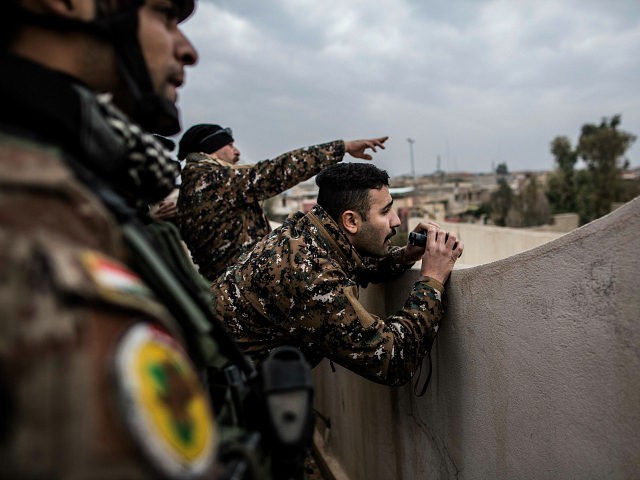The Pentagon has confirmed that among the weapons the Islamic State is using to slow the Iraqi Army’s progress in Mosul are small drones carrying grenade-like explosives, which have caused civilian, as well as military, casualties.
“As we’ve made our way into Mosul now, what we’ve seen is that they use the smaller drones… they’re up for, you know, 45 minutes, an hour so, and even that evolution has transitioned in the beginning of the Mosul campaign from — from just reconnaissance to they are actually putting munitions in them,” Col. Brett Sylvia, head of the U.S. Task Force Strike in Mosul, told reporters on Wednesday.
“I can tell you it has resulted in the damage to some equipment and damage of some structures as well as to some civilian casualties because,” he noted, as the Islamic State is “not concerned about whether or not any of the civilians in Mosul are killed or wounded.”
He described the explosives being tied to these drones as “akin to a small, little grenade” but dismissed them as makeshift devices incapable to hindering the progress of the Iraqi Army significantly.
The Islamic State’s development of a new explosive delivery technique highlights the progress that the Iraqi Army — assisted by Iran-backed Shiite militias, the Kurdish Peshmerga, and U.S. soldiers in advice and assist roles — has made in capturing large parts of Mosul. Other signs of desperation come in the form of local reports of the Islamic State depending on unorthodox measures, such as elderly jihadi suicide bombers, for attacks. Iraq’s al-Sumaria TV reported this week that witnesses saw a septuagenarian would-be suicide bomber drown himself in the Tigris River after failing to detonate the bomb he was responsible for. Al-Sumaria’s witness said the elderly man was part of an attempt by ISIS to “raise the moral of its fighters.”
Mosul remains ISIS’s biggest prize in Iraq, the second-largest city in the country and its regional capital, second only to Raqqa, Syria. Earlier during the operation to recapture Mosul, which began with coalition fighters sweeping the city’s suburbs and securing the perimeter around the city limits, Islamic State jihadists were much more adept at delivering improvised explosive devices (IEDs) by car. In December, coalition forces confirmed that, using airstrikes to crater the roads leading into liberated areas of the city, ISIS had largely lost that ability.
Now, Iraqi forces are embroiled in a door-by-door infantry operation to eradicate every last possible Islamic State terrorist from the city. The Kurdish outlet Rudaw gained exclusive access to the Iraqi Army’s moves in battleground neighborhoods of Mosul, publishing video showing the fight up close near Mosul University.
The Iraqi government forces confirmed to Reuters on Thursday that over 85 percent of east Mosul has been liberated from Islamic State presence, an advance U.S. Islamic State coalition envoy Brett McGurk heralded as a “milestone” moment for Iraq.
Another senior Iraqi military official, Lt. Gen. Talib Shaghati, told the Associated Press that the full liberation of Mosul could be as close as three months away. He warned, however, that “guerrilla warfare” may lengthen the process of removal all Islamic State elements from the city.
While the progress has liberated many civilians, it has also left their neighborhoods in ruins. What used to be pivotal infrastructure centers, like local hospitals and the University of Mosul, have suffered significant damage or been blown up completely. In a report from the ground in liberated Mosul, Reuters notes that many of the requests civilians have of the military are “largely mundane,” such has help digging their cars out of mud pools or fixing their plumbing. Many of them accept when soldiers stand around just to listen.
The United Nations estimates that 47 percent of casualties in the Mosul battle so far have been civilians, significantly higher than the average conflict rate of 15-20 percent (to the extent that calculating an “average conflict rate” for civilian casualties is possible). “In the majority of cases, the overwhelming majority, civilians are being directly targeted by ISIL,” UN official Lise Grande said. “They’re being shot as they try and leave the city and they’re being shot as they try and secure food and other resources.”

COMMENTS
Please let us know if you're having issues with commenting.